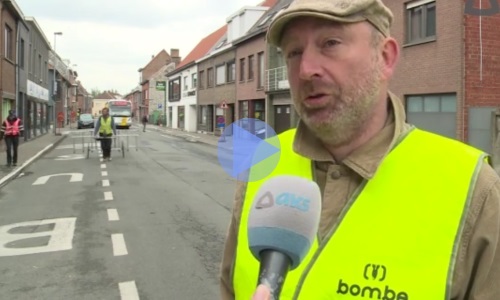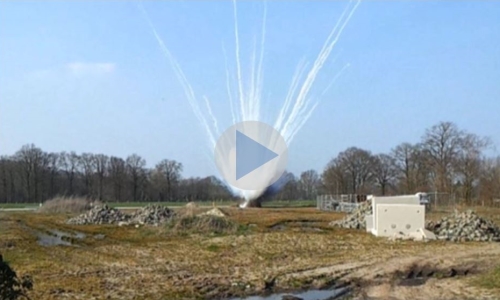UXO projects in 2015
In 2015, we completed about 90 projects, most of them EOD projects. Some examples are listed below.
Dozens of shells in Diksmuide
The “Ijzer Noord” area in Diksmuide is designated as a mixed urban area, with spaces for local businesses, offices and community facilities. The development of the new business area started with an archaeological survey, assisted by Bom-Be ammunition experts. They found 24 shells of different nationalities and large calibers, including fired (armed) and exploded shells, and an unfired Mortar Van Deuren. 28 detonators were also found. As always, we handed these items over to DOVO, the Belgian EOD.
Assistance to groundworks at the Kuringen Carrefour
In July 2015 , Carrefour started to work on the Kuringen site for the construction of a new Quick restaurant, a new Decathlon and utility lines. Workers discovered an American 250 lbs. airplane bomb, meaning that other finds of war munitions were possible. To avoid further security risks and work interruptions, Redevco contractedBom-Be for assistance to excavation works of the foundation plinths. In this process, no more ammunition was found.
Historical research for Belgian railways
Bom-Be conducted an historical study and a risk analysis for the Stations Division of Belgian railways (NMBS), in view of the modernisation of maintenance facilityin Ostend, Southeast of the Zwaaidok. During the past wars, the train station was heavily bombarded. For such a study, our historiansconsult The National Archives (TNA) in London and the National Archives and Records Administration (NARA) in Washington, among other sources. After the analysis of the collected war reports and georeferencing of aerial photographs, we were able to provide a detailed risk assessment.
Survey at the Thiepval War Memorial
Subterra Consult is currently drawing up the management plan for the Common Wealth War Grave in Thiepval France, which is also home to the Thiepval Memorial. This is one of the most important French war monuments, commemorating 72 191 missing British and South African soldiers from WWI. In order to draw op the plan, Subterra wanted to know the position of different utility lines, and if ammunition from World War I was present. Therefore, Bom-be performed a combined survey of the area, with GPR and with a multisensor magnetometer. This allowed us to map out the location of the utility lines, as well as possible suspect objects. This information was the basis for our advice concerning the upcoming management operations.
EOD / line detection – surface detection – magnetometry / GPR
Ammunition search in Fort Aubin
The municipality of Dalhem, located between Liège and Fourons, contacted Bom-Be to perform a detection and approaching of UXO near the Fort of Aubin, where the construction of a museum was planned. During the Second World War, the Germans used this fort as test site. They fired Röchling missiles at the fort, which were designed to destroy deep bunkers. We found no remnants of these rockets, but we did find a dozen of artillery ammunition items.
Grenade search in Hasselt
In 2015, IKEA constructed a new branch in Hasselt, on a site where a case of detonators was found during the cleaning of a well in the year 2000. Consequently. Reason enough for IKEA to commission an historical survey from Bom-Be. Based on army reports and witness testimonies we could ascertain that a Belgian artillery regiment had been stationed in the area during the invasion of the German army in 1940. This regiment probably left behind artillery grenades during retreat manoeuvres. Consequently, Bom-Be was asked to perform a surface detection. Even though the terrain was a bit rough, we were able to cover most of it with a multisensor surface detection, which revealed the presence of several anomalies in the soil. Approaching the suspect objects yielded a lot of metal utensils, scrap and some 18th century coins, but also 123 French 75 mm grenades (HE and shrapnel), 307 detonators (of which 26 in the same well), and about 12 kg of black powder. All ammunition and explosives were transferred to DOVO, the Belgian military EOD.
In the summer of 2015, another 75 mm French grenade was found in an area that hadn't been detected by Bom-Be. In the area, we assisted further excavations, but no mre grenades were found.
EOD – historical survey / surface detection / approaching / assistance – magnetometry
Assistance to groundworks at Stockem station
NMBS, the Belgian railway company, contacted Bom-Be because an American 40 mm WW II shell was discovered during groundworks at the train station of Stockem (Arlon). Due to the large metallic contamination of the top soil, a surface detection made little sense, so the experts of Bom-Be assisted further excavation works. We found 4 more non-fired German artillery shells of 75 and 77 mm. They were possibly mixed in with soil that had been brought in earlier from an another location.
Detection in the streets of Melle
During World War II, the train station of Melle was an important junction in the supply routes of the German army to French occupied territory. Therefore it was intensively bombarded by the allies, in preparation of the Normandy landings. FARYS, a water company in Flanders, planned to carry out major sewer system works, and wanted to know beforehand what was hidden in the soil. Indeed, an airplane bomb had been found in April ’15 on the same location, resulting in the evacuation of 2900 inhabitants. Bom-Be had already carried out an historical survey of the area (see our projects of 2014), showing there were clear grounds for a multisensor surface detection, which we carried out in May 2015. The streets were closed off, and we carried out a surface detection under police guidance. Public transport buses were allowed passage, on the condition that they kept a distance of at least 10 m to our multisensor cart, in order to avoid interference with the measurements.
This detection was also featured in the TV news broadcasts of VTM and AVS.
Historical research and depth detection at the VUB
In view of the construction of a new swimming pool for the University of Brussels (VUB), ECOM asked Bom-Be to do historical research on the location of ammunition in the area. In the Second World War, Ixelles was heavily bombarded as a result of the navigation error of an American bomber formation. We were able to delineate the suspect area, based on the information gathered by our historians in the war archives of London and Washington, and concluded that the project area was part of that area. Therefore, the experts of Bom-Be conducted depth detections on the locations of the foundation piles. On these specific points we didn't detect any suspect objects.
Incendiary bombs in Bree
The City of Bree is planning the construction of new industrial site of about 280.000 m2, on a meadow where an archaeological sample trenching survey had revealed the presence of trenches and two incendiary bombs. Reasons enough to call on Bom-Be for a surface detection of the entire area.
With a quad and multisensor cart we scanned the site, except for some waterlogged and material storage areas, which will be addressed later. The detection aimed to discover various calibres, ranging from bullets to aerial bombs, with more than 2000 anomalies as a result. When the City of Bree asked us to approach the suspect objects, we decided by mutual agreement that we wouldn't consider the anomalies on former building grounds as possible UXO. At quite shallow depths – 10 cm and 30 cm – we found two more English 30 lbs incendiary bombs, not far from the aforementioned trenches. When we reported our find to DOVO, they decided to destroy the bombs on the spot. This video shows how this went about.
The German helmet and the tortoise
Early 2015, Aeres Milieu performed an archaeological sample trenching survey at the former Barracks of General de Bons in Grave (The Netherlands). A previous historical study by Bom-Be (see projects 2014) had shown that the site was suspect for the presence of ammunition from WWII and the period after. Hence, Bom-Be executed a surface detection which revealed a lot of anomalies with the characteristics of ammunition. Aeres then askeded Bom-Be to assist the archaeologists with their excavations. We encountered lots of small arms ammunition, remains of ammunition as well as other witnesses of the past, like a German helmet with a bullet hole in it.
EOD – historical survey / surface detection / assistance – magnetometry






